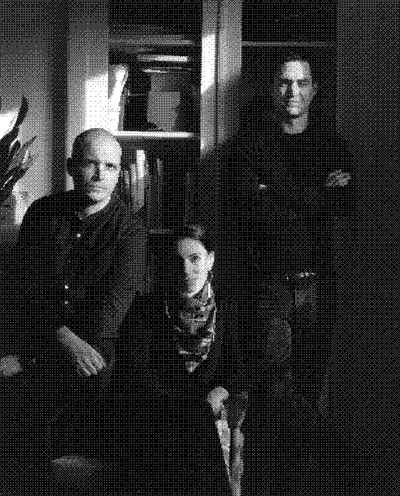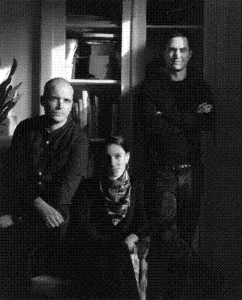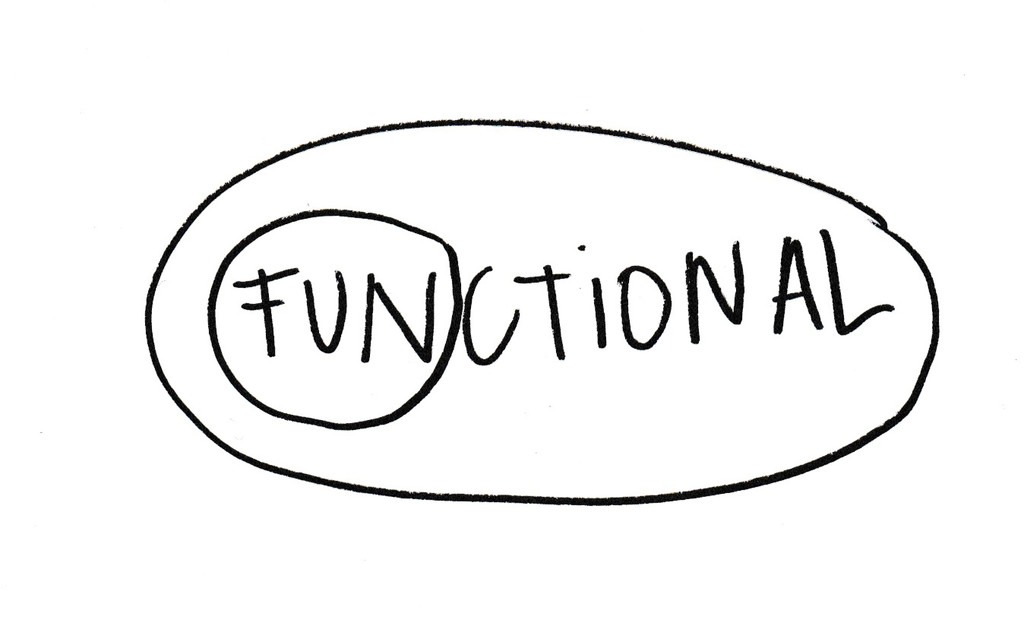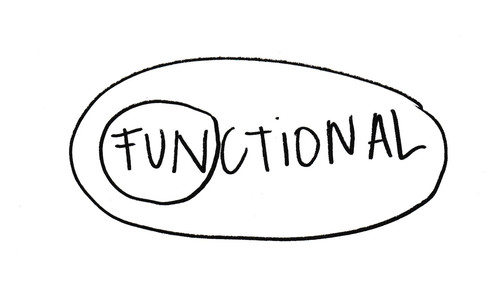Could you please tell us where you come from and describe your career path?
I was born in Kortrijk in Belgium and studied fashion design at the Royal Academy of Fine Arts in Antwerp. I received a Bachelor’s Degree and then a Master’s Degree in 2009. I interned a lot in fashion, working with clothes for two and a half years. I got into accessories during an internship with Lanvin. In a flash I knew this is what I wanted to do. I felt I wasn’t super‑talented for clothes but I was so dead set on working in fashion. I got the opportunity of interning with Maison Margiela in the accessories department. I was 27 or 28 when they hired me, and I stayed with them four and a half years. It was an incredible first job. Margiela was familiar to me as a name but I wasn’t that intimate with his work, which I realised that I loved. Then I began working as a freelancer, first with Margiela and then with other brands such as Y/Project and Jil Sander. After a year and a half of freelancing, I worked for Dior with Charlotte Chesnais, thinking it would be a cool experience, and I stayed there a year. Then I went back to freelancing with Y/Project and then APC. But it felt like I was just repeating what I had already done. So I thought about it and decided to launch my own brand. It took a while, I had already launched a small legging brand, it was really cool but a little naive. If I launched something, I wanted to make sure I had the right people around me because in the meantime I had gained knowledge, experience, and some excellent clients. I didn’t want to imperil that so I was facing some pressure. I ended up finding the right people I wanted to work with but then I kept delaying because I knew that as soon as the brand was launched I would have to produce a new collection every six months. I presented the first collection in January 2018. Which means that my seventh collection will coincide with our three‑year anniversary. I continue to freelance, mainly jewellery and belts for other brands; for my brand I also produce leather goods… I very much appreciate the fact that I don’t always have to work on the same thing; I like collaborating. I like teamwork; it inspires me.


Portrait by Valentin Herfray


D’heygere logo by Adulte Adulte
In an effort to remain dynamic?
Yes, and to discover new and exciting solutions.
How would you describe your brand? It’s been three years now, so it’s no longer a fledgling brand; has it grown? Do you feel like it now has a foothold of sorts?
It’s an accessory brand based in Paris, a conceptual brand that is idea- rather than design‑based. It’s rather minimalistic, not decorative in the slightest. There’s a kind of impersonal, timeless side to it. I don’t want my designs to simply express fashion trends. The idea is to be an accessory brand in the broadest sense of the term. We make lots of jewellery, leather goods and caps. I dream of shoes, eyewear, and I would very much like to create more objects.
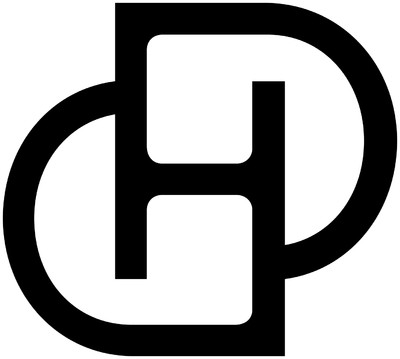
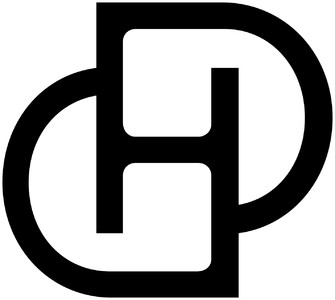
D’heygere monogram by Adulte Adulte
You mentioned Margiela as an influence. Did other brands inspire you as well?
Margiela, yes, because it’s a conceptual brand. He’s kind of unique in fashion since brands are mainly focused on producing pretty things. I like it when a little more thought goes into it.
In truth, I get my inspiration from artists who “divert” or “transform” things – such as Erwin Wurm. I love everything he does; his One Minute Sculptures are a great source of inspiration. Fashion itself inspires me less.
And on a broader level, have any other artistic currents inspired you?
I love Dada, the surrealists, and I must say I’m not averse to pop art, it’s totally innovative and again, uses transformation as a tool. I also love conceptual art in general, Marcel Broodthaers for example; his aesthetic is incredible.
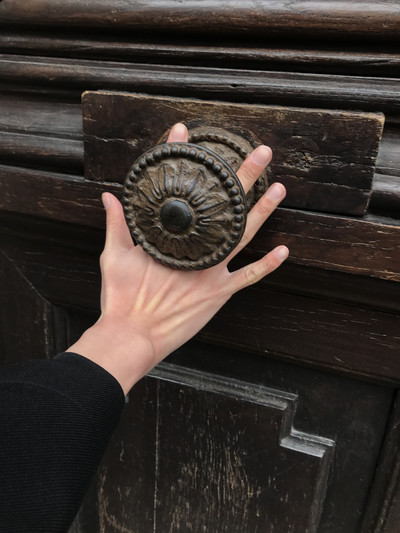
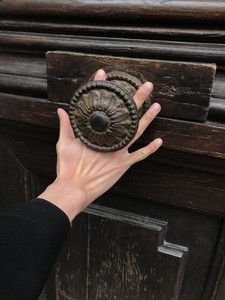
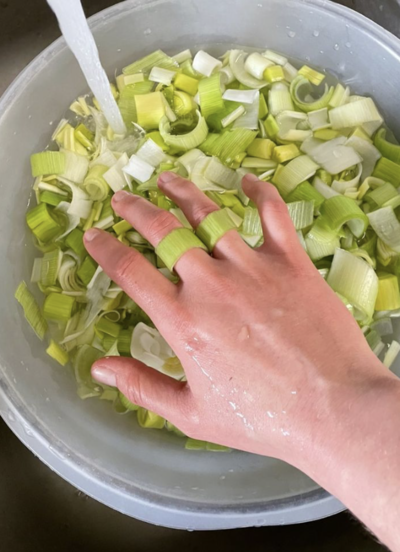

A word on your state of mind as the year gets underway?
I’m holding on …! (laughs) Creatively I thought it would affect me more because I love finding inspiration on the street, at the flea market, on the subway or while traveling abroad, observing people – which obviously was off the table. I did have a moment of panic during the first lockdown, I didn’t want to get depressed and I really wanted the next collection to be entirely new. It turned out that I designed the whole collection at home by myself as well as two other collaborations. When you see the collection, I don’t think you would guess it was created during a pandemic, which is pretty cool. I think you can remain creative in all circumstances. The second lockdown didn’t affect me as much because I went to the office every day. I do need to relax, to go out and have a drink with friends, a cup of coffee at an outdoor table. It’s starting to be tough. But it’s okay.
What differentiates you from your competitors?
You’ve got to look at the whole package: good design and a good visual identity. You can have good design but completely screw up your image. You’ve really got to strike the right balance. Products, photos, models: a brand is so many things; and design isn’t necessarily the most time‑consuming aspect of it. I try to inject humour into what I do without being too over the top and I get the impression that people like it. It’s also a very realistic brand; we’re not about selling the dream. We don’t use stereotypical models; we take lots of photos in the street with our iPhone. We’re a luxury brand, our products are rather expensive, the jewellery is made out of silver 925, we have leather goods as well. For me it’s also about durability: if you make elegant products out of beautiful materials, people will keep them for the rest of their lives and if they have kids they too are going to want to wear earrings, it’s a kind of legacy, really. To sum it up: humour and reality.
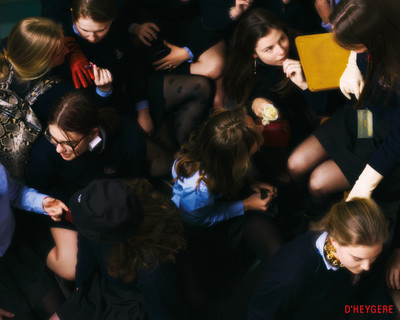
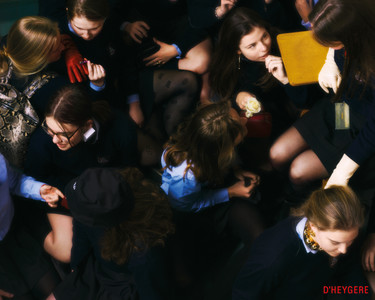
Photograph by Arnaud Lajeunie
Does this all‑encompassing approach sum up your personality?
I was going to say, this brand is really me. It can only function that way. When I design things, it’s also: “Do I want to wear this stuff?” ‑ it’s my taste. And César’s, too.
Who is César, what’s his position within the company?
César’s my right‑hand man. We work well together because we do radically different things. He’s responsible for the business, logistical, accounting side of things, his role is somewhat less creative but he has good ideas! I treasure his input. He’s also my happiness manager!
How long – from design to production – does it take to produce a jewel?
It can go very fast. This year I had so much work that I began working on the collection in December and it launched in late January. I was in Italy, I got to see the prototypes, it was easier to go there and make changes onsite. My suppliers now have a good idea of my likes and dislikes, so things go more smoothly.
Always the same suppliers?
The same since the beginning! So the process takes about two months for the jewels. As for the bags, that can also be very quick, I look at the first prototype and the second will usually be good enough for the showroom. There’s usually just a couple little glitches or logo issues that get fixed before launching production. Around a month and a half for the first prototype, then around a month for the final product; so in all, three months.
Do you need to create enormous quantities to find a jewellery design that satisfies you?
My ideas are direct; I visualise them. Then, when I see the prototypes, I improve them. For example just recently I cancelled two or three pieces because we didn’t have time to perfect them so I’ll keep them for next season (or not!).
And how about when you work freelance?
That’s different because then I have someone above me: the AD’s going to tell me if he likes it or not, so I’m really working for other folks. That’s why I love being my own boss. (laughs)
How in your designs do you discover the kind of diversion or transformation of a given piece? Is there one particular piece of yours that exemplifies that aspect of your work? Or do all of them?
Not all of them. A collection should express a variety of things. And that comes with experience. You look at what sells because you’re a brand after all, you need to be successful to continue, to keep hiring and growing. But sometimes it can be very simple: a ring worn as an earring, or else the material: sand‑covered pearls, the grain of sand referring to the pearl in an oyster. It’s really a kind of trompe‑l’oeil, a recurring theme; the pocket belt is an example of that.
It’s really very broad, I follow these codes and each season’s products are easily categorised: transformative, ready‑made, trompe‑l’œil.
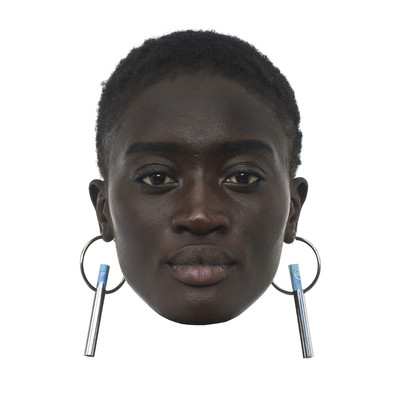
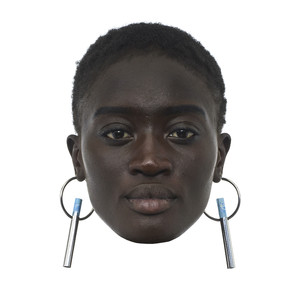
D’heygere Canister Hoops by 5 Fruits
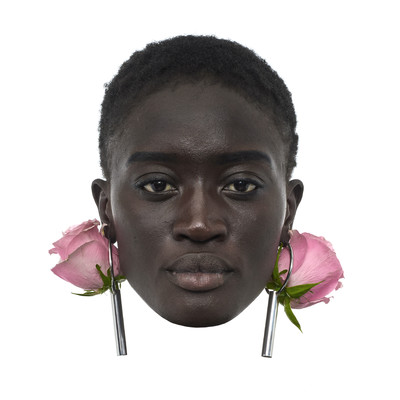
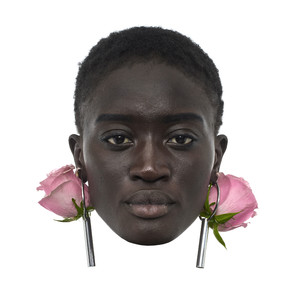
D’heygere Canister Hoops by 5 Fruits


D’heygere Canister Hoops by 5 Fruits
What did you need to learn when you launched your brand?
I was lucky because I worked as a freelancer for small companies that quickly became cool so I got to see early on how things go down – not necessarily in terms of design but the part that César now takes care of.
These experiences were a true inspiration.
What’s the toughest part of your job: management, finance, brand protection?
I don’t just deal with design, I’m involved in development from top to bottom, the entire production process; César and I wrap each order for the shops, we are the brand’s ADs, we do the Instagram posts, plus I have my freelancing. I like to be in control and aware of everything. But since it’s impossible to do everything, I need people I can trust. I made sure to have people around me who are competent in fields that I am not competent in. Now we have a superb team so I hope we’ll all grow together. We launched an e‑shop, and here I admit we have a lot to learn because we are just now realizing that it’s another business entirely, so it’s on‑the‑job training in a way, we’re learning and moving forward everyday so I’m not too worried.
How many people are on your team now?
There are two of us in our Paris office and we always have two interns, then there’s Chloé in London, she’s a regular freelancer in charge of business strategy. So I should say three.
A nice, human scale …
Yes, it’s good. I also had an assistant but she returned to Belgium. I’m going to see if I hire someone else. Not sure, my new intern is very good. If I had to create a new position, I’d love to have a production and development manager in Italy.
Might that lead to other things?
Not necessarily other things but I’d be able to spend more time on what I’m already doing. I’d like to develop the e‑shop and increase our number of collaborations. I have another project I’d like to do with the brand. César does all kinds of things, he’s going to have to settle, to specialise in something so that we can hire people at specific positions. It’s an organic development. There’s a bit of trial and error and for the moment we’re doing all right. I’ve got to say I was a little scared during Covid, but we still had a good year. You’ve got to stay positive: we didn’t collapse and people are getting to know our brand, I’ve only been getting positive feedback.
Is it complicated to have a namesake brand?
In truth it’s like it’s not even my name anymore. The worst of it is the pronunciation that is very different in France compared to Flanders and Belgium so it’s really becoming something else. I had other ideas as far as names were concerned but they all sucked so I thought to myself: “At least if I use my name I can’t get it wrong since it’s my own name”. And graphically it looks kind of nice. The only problem is that it’s impossible for people to pronounce or spell. We even made a T‑shirt with Land Arts, we posted stuff on Instagram (one of César’s excellent ideas) and it’s working out rather well. It’s scandalous really! (laughs)
Did we spell it correctly? We put an uppercase H.
Lots of people do that! My name is spelled with an uppercase D and a lowercase h; I often see lowercase d and uppercase H…
We’ll make sure to correct it, promise… (laughs) In terms of brand messaging your image is very strong. How would you describe it?
It came quite naturally. The image, you see it on Instagram, we also redid the site with Tristan Bagot and Antoine Roux but I think you see it mainly on Instagram and via the community. It’s important to highlight clients and tag them. I built our Instagram a little like a magazine with several categories I file under different hashtags, if you click on a hashtag you get the whole category. It’s something we’ve been developing a lot at the office, we have an Instagram mood board with lots of ideas but it’s all very spontaneous. On my phone I also have an Instagram file though I’ve never planned our messaging in advance. I make sure to avoid repeating the same thing; it takes loads of work, loads of content even though much of it is produced by clients. For ad campaigns, I always work with Arnaud Lajeunie and Ursina Gysi and I love it but there are so many other people I’d love to work with. We built up a carte blanche system thanks to which we can invite people we like to produce imagery for us. The idea was connecting with people I like; there are currently lots of photographers but I could imagine collaborating with a pastry chef, why not. We had a cartoon project with Camille Potte and we’re working with someone who creates make‑up, and an artist called Pepo Moreno who customised our White Board jewellery line. I need to make sure not to lose the initial idea because lots of people contact us when we’re the ones who should be on the hunt for new talents and different media.


Drawing by Camille Potte
You appear to be very close to and attuned to your clientele and ever‑growing entourage.
Yes, I want everything to stay real and accessible. I could use professional models, but no one wants to see that. Our pieces are a little offbeat, so it’s cool to see them in everyday settings on people who aren’t professional models; it’s really important.


Photograph by Arnaud Lajeunie
You talk about your brand as if it were very conceptual. How did the manifesto idea come to you and what other concepts are you currently working on?
It began during the lockdown, thinking that nobody had anything to do. The concept that anything can become an accessory was already inherent to the brand. We turned a shirt into a fanny pack, plus all the accessories in which a cigarette could be stuck. The manifesto was a rather natural expression of this and it caught on immediately. We already had the products; now they’re also on Instagram. I’d really love to put out a book about that one day, that would be great. I’m beginning to get interested in publishing. The next project I’d really like to work on would be to create a second line inspired from the Manifesto but with upcycling. You might compare this to Margiela’s Artisanal, without a doubt, but I’d be more focused on found objects that we’d reinterpret as an accessory, limited yet affordable pieces. The series will be small, but each piece will be limited and I’d like to do that for jewellery, belts, etc. It’s an approach that requires a lot of sourcing, and these days that’s almost impossible.
For a brand such as yours embracing reuse, upcycling, and second‑hand is good strategy, is it not?
I think it’s a good idea to lend a second life to something instead of throwing it away, the brand’s idea is also that things should continue to exist even if that sometimes means a reboot. It would be a very satisfying way of continuing what we have already done. The question is if we would use the e‑shop for this or physical shops since it’s tough to explain to each individual client that they’re not going to get exactly what they’ve seen online. This needs to be tested in a physical showroom, we’ve got to discuss it with the buyers. I’m excited about this project but for the moment it’s on hold…
Is it strategic of your brand to be working in this case with agents that supply the material for upcycling or other jewellery fashion brands that could help you obtain second‑hand material?
There is some of that, I think it would be cool to work with craftsmen to retool these pieces. There’s lots that’s positive in all this. The thing that’s important is to be more than a fashion brand. That’s also why we did the Manifesto. Usually, brands make products and try to sell as many units as possible. I’d like to show that we’re more open: we present our products twice a year in a showroom but I’d like us to have more surprising collaborations either in terms of products or people, which is why we launched Carte Blanche. We don’t want to rest on our laurels which is why we always attempt to go a little farther.

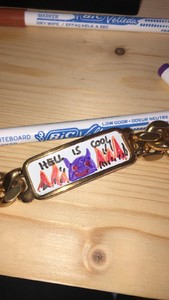
Pepo Moreno
When you way say surprising collaborations, which ones come to mind among those you’ve already done?
Bic I thought was pretty cool because you wouldn’t expect that kind of association for a fashion brand. That’s the advantage with collaborations: to associate two companies that create completely different products or who have a completely different set of skills. It’s also surprising to see two competing jewellery brands collaborate. I’m also trying that angle. I’d love to set up that type of partnership, it’s in large part what Chloé and César are involved with. We’ll see. The brand is starting to become famous but remains relatively niche and that’s something that could scare off the big brands.
Have you ever had a stand‑alone counter in a department store?
Not really, since our collections are too small and we’re not well‑known enough. We’ve already done one month stints in stores. That’s almost like what you’re talking about. But it’s still too early in our development for that.
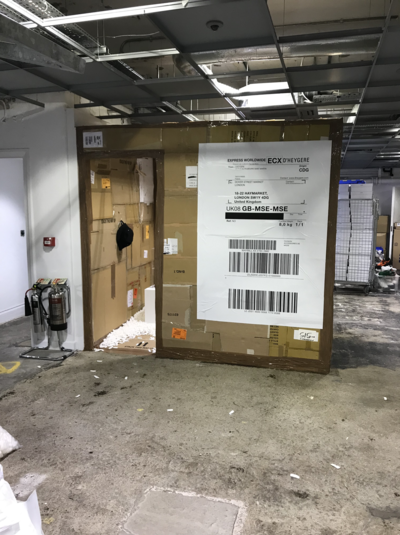
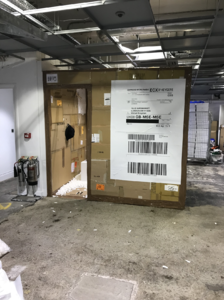
Installation at Dover Street Market


Installation at Dover Street Market
Would you like to or are you uninterested in that?
It’s still early days; I’m waiting to see what happens.
Could we talk about your latest campaign?
It came out mid‑December and it was the Fall/Winter campaign so the products are no longer in the shops. But I wanted the campaign to come out, it was the icing on the cake, it was too cool for us all to be able to work on it. The preceding campaigns were a return to my childhood in Belgium with the beach and boarding school and a spur of the moment cast. This time we decided to concentrate a little more on the product, so the idea was the opposite of the manifesto. According to the manifesto anything can become an accessory. Here the concept was that the accessory can become something else. We have the bag whose shoulder strap is made of rings that remind you of the rings on packs of beer so we put beers in the shoulder strap. Transforming the object. I was expecting still‑lives. Arnaud pushed for a more human touch. He was completely right. So you see a little less but Antoine Roux added a text to underscore the ideas and I am very happy with the result. It worked very well with this collection because it’s eclectic as well as extensive. When I think of the collection that’s coming out now, we couldn’t have done the same thing. So it’s perfect. I’ll want to do something different next season. It’s important to renew yourself always.


Photograph by Arnaud Lajeunie
What in 2010 did you think you’d be doing in 2020‑2021? How did you imagine yourself?
How old was I then… 26, I had just interned in LA. I wanted to stay and live there but didn’t think I’d have a brand one day, that wasn’t my dream yet. I dreamed of working for a great company, I had always dreamed of working for Chanel… I hope it’ll happen one day. Chanel or Hermès. But I’m obsessed with Chanel. When I have an idea I go for it… I studied law, and then I told my parents I wanted to get into fashion and I failed the entrance exam at Antwerp twice in a row but I am very persistent and ambitious and my parents supported me. I didn’t think I’d have a brand, much less an accessory brand; I thought I’d design clothes but got into accessories, and I’m glad.
At the same time brands are less pigeonholed nowadays, don’t you think?
Yes, absolutely.
You can have a really strong identity in one area, and yet experiment with lots of things also… and this can save you during a pandemic, am I right?
That is correct!
If you could fix something in your development?
I can’t say I made bad choices or mistakes and even if I did, that’s how you learn. I think I’ve got the right people around me and I was prepared. One of the reasons it worked out is because I had experience.


All the internships, the people you met, your network?
Exactly, after school lots of students went for it right away but that’s impossible and I think school shouldn’t encourage that. As I was saying, the design aspect of my brand takes up 10% of my time, there are so many other aspects… You really need experience and good people around you. I could put more time into my brand but I love freelancing and I think curiously enough that my freelancing is beneficial to my brand.
Does your freelance work pay your salary? And do you use that money to develop the brand?
Yes. I prefer to invest in my brand to help it grow. We’re going to see this year, we’ll see after the next showroom… That’s what we always say. (laughs) But that’s okay, this brand is my baby and I give my baby everything! (laughs)
Do you teach? Do you share what you have learned somewhere?
I teach at HEAD in Geneva. I love that, I love my exchanges with the students, I would have loved to have had that at school. To be in direct contact with professionals from my chosen field.
workshop Stephanie D’heygere_x_ecal
Your model is based on sharing; is that linked to what you learned during your internships or does it come from your personality?
A little of both: I love to work, I love to be active, to jump from one thing to another. I realised after Dior that spending my days in an office was not congenial to me. When I was at Dior I was a designer so all I needed to do was create jewellery and it’s impossible to do that every day of the week. You could go out to an exhibition but that wasn’t work. Being independent is complicated, you have no financial security but on the other hand you have your freedom… The people I work with for example, César I hired full‑time, I give him free rein. I know I can trust him, he’s responsible enough to know what needs to be done and when.
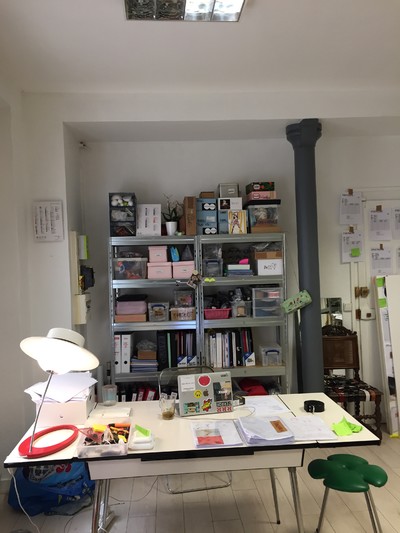

D’heygere’s office
Do you and César have a business plan?
Not really. We make forecasts, but it’s not easy. Each year is different. Now with Covid it’s impossible. We launched an e‑shop. It’s super hard to predict how many units we’re going to sell and we had to place our orders in advance. We also have collaborations and sometimes money is involved, sometimes not. Our revenue sources are quite varied. But if I start setting targets and we don’t meet them, no one can do much about it. People are surprised that I don’t have a business plan but it’s all right. We’re still small. We’ll cross that bridge when we get to it.
Do you keep an eye on what other accessory brands are doing? Are there accessory brands whose development has impressed you?
I’ve noticed that there are very few accessory brands such as ours, because we produce several categories of products. Usually brands that produce jewellery and bags are ready‑to-wear brands: Dior, Balenciaga… that’s exactly what they are. Otherwise you’re either a jewellery brand or a shoe brand or a producer of leather goods. At first I thought it would benefit us to be a more complete brand but I have discovered that it’s harder for the shops: they don’t really know where to place us… Usually in concept‑stores you have all the jewellery together, then the leather goods elsewhere. We don’t want the shops that carry us to restrict themselves to the jewellery.
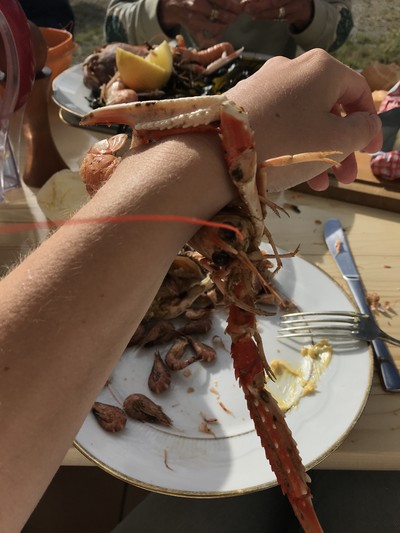
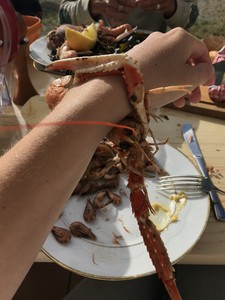
Has this been solved today? Do they buy everything now?
Yes, they now accept our being a complete brand. But there are still shops that are reticent. At first we insisted they carry our various lines but we’re starting to be more flexible in order to increase the number of stores that carry us. So I can’t compare us to other accessory brands.
How about fashion brands that’ve had a more fluid development over time?
In terms of business, my dream model is COMME des GARÇONS. I love that brand. They don’t do a lot of accessories, but they still have beautiful leather goods and they also invested in young brands, especially through their concept‑stores. It’s incredible. Another thing I’ve thought of: it would be incredible if I could have my own jewellery factory that could perhaps work with other jewellery brands, do some subcontracting. That would be super‑duper.
That kind of development would take several years, don’t you think?
Yes, absolutely. Lots of brands have their own factories; it’s a good idea. I must admit that I don’t pay too much attention to what my competitors are up to. I did notice that Charlotte Chesnais opened her shop. I saw that because I knew her at Dior and when we met, her brand was just starting out, so it’s great. I take a look at what the others are doing but not with the idea of doing the same thing. It motivates me to see people doing things well; it gives me a boost. (laughs)
You don’t have a three-, five-, or ten‑year plan? You mentioned factories, a collection of objects for the home?
Whether in collaboration or for the e‑shop, I have lots of ideas but we haven’t set any deadlines. We’d like to collaborate with certain brands, we’re just waiting a little. Honestly I don’t want the old guard to get involved. I asked myself if we needed a mentor, someone who had already helped other brands grow, but I don’t want to get into that for the moment. The idea is for the brand to grow, but not like other brands who grew too rapidly and subsequently collapsed. I’d rather grow slowly but forever.
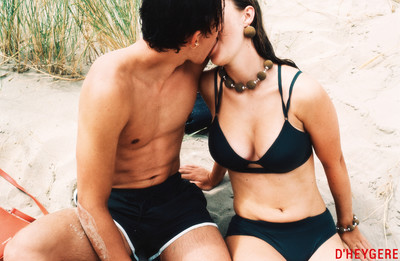
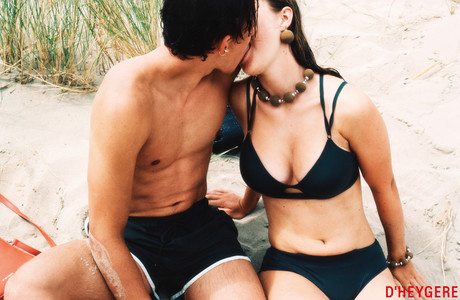
Photograph by Arnaud Lajeunie
What could take your brand to the next level?
I always make sure that something new is added each season. Whether collaborations or products. If we add new products it means new factories but since we don’t produce large quantities it’s difficult.
An investor?
I already thought about it, but I’d have to be sure to need more money. For the moment we’re managing alone, so no.
How about celebrities spontaneously wearing your accessories?
Now that’s something I must say has not much happened in terms of PR. During the first lockdown we had several zooms with the team with lists of potential ambassadors for the brand (it was kind of funny) but we need to get back to it. With the e‑shop it would be perfect since it could push certain products. I’d like to give pieces to people who touch me personally or who inspire me but that’s not a business approach. We have to strike the right balance.
Would your idea of Carte Blanche jibe with emerging talents and celebrities pushing the brand?
It would be perfect, but it requires a budget: Do you give away the products? Will they wear them? Rihanna has already worn our earrings and posted it on Instagram but without tagging the brand so you can’t repost it but even that doesn’t necessarily guarantee that we’ll be getting 100 orders afterward. I don’t know to what extent our clientele is influenced by the star system. But we should test it out!
How about in terms of price range? Would you like to increase your prices? Are they fair at the present time?
We don’t pull our prices out of thin air: you have production costs, then our profit margin and the shop’s. It’s a vicious circle, we don’t sell a lot yet because we’re a young brand and because our accessories are expensive, but as long as we don’t sell a lot we can’t produce more so I can’t negotiate better prices… But I find that as far as market prices go we’re not that expensive. If compared with Dior or Balenciaga I would say that we are in the same price range but our jewellery is silver 925 not brass so technically it’s less expensive. Production costs are by weight and we produce heavy pieces so it’s more expensive. They cost the fair price. We’re careful and we also added some smaller pieces that sell well because I understand that not every soul can afford to pay 400 euros for a pair of earrings. But I hope there’s a thought process that underlies the purchase and that they realise the durability of the piece of jewellery they buy is a gauge of its value.
A couple of trivial perhaps questions: If you could work at another time in history?
In the 1980s. But the same job!
Or a creative profession at another period in history… it could be the future, too?
Oh no, not the future! I would never go for the future. But I find that we’re lacking some decadence. In the 1980s everything was a little more crazy, people really made sure to go all out. Before the pandemic if I was going to a party I left directly from work so I have all these gorgeous bags and beautiful shoes that I never wear … And that’s really a shame! If I want to go far back in time, I’d say the Egyptians… they were already wearing nice jewellery and finery at that time …
A book that helped you gain a better grasp of what you do, or that inspired you?
I don’t read a lot of theoretical books but I love buying books, I love looking at books. I love the period in time when I’m about to launch a new collection, about a month or so during which my team and I go to exhibitions, spend the weekend in a city, go to the flea market but I haven’t done that for two seasons now… and since I miss that I’ve begun to buy more books to compensate.
I already cited One Minute Sculptures by Erwin Wurm but otherwise lots of books on contemporary art, I have lots of books on jewellery, accessory encyclopedias (to explore the types of accessories without being bogged down by photos…) And this, I forgot to mention, so instant preview: we’re going to create a dictionary for the brand. We’re launching a collection of alphabet earrings that’s coming out in stores in June and the dictionary will probably come out simultaneously. It’ll be the D’heygere alphabet, with different kinds of accessories, the names of the material used, all humorous; it’s another thing entirely and might turn into a book. Our own personal index of the brand which will initially appear on our site.
Are there people who have helped your work evolve?
All the time… At first I tried to do everything myself but it’s true that I love talking with people. With Instagram it’s fantastic, I see so many things and distance is no longer a problem, you can contact someone who’s in the USA. I work with Bureau Antoine Roux; I had never worked with an AD before… exchanging with people means evolving. Key people… I love talking with my friends who have launched their own brands. Before I might have been less interested in what I was less aesthetically attracted to. Whereas now that I have my own brand I realise that it’s really not easy and I respect everybody who has launched their own brand.
Advice for someone about to embark on a creative career?
What I said before: get experience. And when you think of your brand, there are so many things on the market it’s a little egocentric to say that yours is going to be successful. But it’s necessary that people create brands, it nourishes the spirits, we all come from a different era, we all have inspirations and different influences so the young generation is super important. You shouldn’t be afraid to go for it but you’ve got to be prepared and you’ve got to understand what that means. You have people who believe in you, people you invite to the showroom, journalists, so it’s tough when it doesn’t work out. But you have to believe, you have to give yourself a little time.
